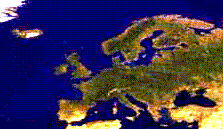

Summary
From around 150,000 to 130,000 years ago, Europe experienced colder and more arid than present conditions. About 130,000 years ago, a warm and relatively moist phase began, and this lasted until about 115,000 years ago. Subsequent cooling and drying of the climate led to a cold, arid maximum about 70,000 years ago, followed by a highly unstable phase with generally more moderate climates, and then a second aridity maximum around 22,000-13,000 14C years ago. Conditions then quickly became warmer and moister, and similar to the present, though with a strong cold dry event around 11,000 14C years ago. Early Holocene conditions seem to have been slightly warmer than at present, peaking around 8,000-5,000 14C y.a. across central and northern Europe. However, there may also have been other significant temperature fluctuations, following a 1500-year ('real' years) cycle, throughout the Holocene. The strongest cold events seem to have been about 8,200 and 2,600 14C y.a. Broad scale deforestation became significant after about 4,000 14C y.a., and was most rapid around 3,500-2,000 y.a.
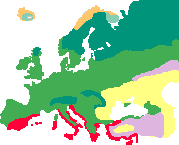 Europe present-potential vegetation
Europe present-potential vegetation
This is the vegetation cover which would exist in the absence of agriculture, and which does exist at present in a highly fragmented form. Forest (green) predominates across most of the region, with deciduous forest across central and western Europe, and conifer forest (blue-green) towards the north and east. A steppe (grassland) belt exists in the south-east (yellow), with areas of forest-steppe (pink). Tundra (orange) exists in the far north where the climate is too cold year-round for trees to grow, and mediterranean vegetation - with hard-leaved evergreen shrubs and trees - predominates in parts of southern Europe (red).
present-potential vegetation boundaries
Early Eemian interglacial warm 'optimum' (from sometime around 130,000 y.a. to about 125,000-120,000 y.a.) (Isotope Stage 5e).
The timing of the Eemian warm 'optimum' in Europe, if indeed there was a coherant warmer-than-present phase, is somewhat elusive. The warmest stage of the early Eemian falls at about 125,000-120,000 y.a. according to van Andel & Tzedakis (1996). Velichko et al (1992) present a climate map for the 'optimum' which they suggest occurred or was still occurring at 120,000 y.a., a relatively late date compared to many west European authors, and also those who regard the peak Eemian warm period (in terms of both summer and mean annual temperature) as synchronous with global events recorded in Antarctic ice cores. These other sources would put the peak year-round average warm period in Europe at around 130,000-125,000 y.a.
The general ice core chronology from Antarctica suggests that peak global early Eemian warmth may have been around 130,000-125,000 years ago, with a gradual cooling to more similar-to-present conditions afterwards (the dating of the peak interglacial deposits is subject to considerable error this far back in time). Whatever its detailed timing, during the warmest phase of the Eemian in Europe, temperate forest extended much further north than at present, with temperate hazel (Corylus) and alder (Alnus) populations growing near a site in Swedish Lapland (67 deg.N) (van Andel & Tzedakis 1996). During the earliest Eemian, Scandinavea may have been an island cut off by an extended Baltic seaway, judging from the distribution of ancient marine deposits, and this is shown in the map of van Andel & Tzedakis (1996). Note that the depression of the land at this stage might have been due to exceptionally rapid deglaciation which left insufficient time for upwards 'rebound' to occur after the ice had been removed.
Across most of Europe, it seems that there was a broad succession in forest composition during the early-to-mid Eemian, with an initial pine (Pinus) phase during deglaciation followed by such species as deciduous oaks (Quercus), hazel (Corylus) and hornbeam (Carpinus). A yew (Taxus) phase north of the Alps sometime between 130,000 and 120,000 y.a. suggests relatively dry, warm summers and mild winters and is generally marked off as the warm 'optimum' of highest year-round temperatures (though other indicators suggest moister than present conditions during all or part of the warmest phase; see below). Other plants suggesting greater-than-present warmth from their Eemian distributions in northern and central Europe include the shrubby Montpellier maple (Acer monospessalanum) and the water chestnut (Trapa natans). Mean temperatures some 2-2.5 deg.C above present values are suggested for this 'optimum' phase (van Adel & Tzedakis 1996).
After about 115,000 y.a. there was a strong replacement by spruce (Picea) and then pine once again, followed eventually by an opening up of the vegetation due to aridity and cold.
In the Mediterranean region, an early deciduous forest phase was followed by a phase around 125,000 y.a. with more 'typical' species such as Olive (Olea) and evergreen oaks (perhaps suggesting greater summer aridity?).
An Eemian 'optimum' climate map has been published by Velichko et al, based on their review of diverse sources of evidence (but mainly plants). They suggest that winter (January) mean temperatures were less than 2 degrees above present values in western Europe, but 2-6 deg.C higher over much of Scandinavea. In the north of Scandinavea, January temperatures are suggested as having been 8 deg.C higher. The same authors also suggest that Mediterranean winter temperatures were slightly lower than at present. In another map in the same volume, Frenzel (1992) takes a slightly different view, suggesting winter temperatures 2-3 degrees higher in NW Europe, and 4-5 deg.C higher across most of Scandinavea. For summer (July/August) temperatures, a 2-3 deg.C warming across most of western and central Europe and Scandinavea is suggested by Velichko et al. (1992), and by Frenzel (1992), but only Velichko et al. suggest a slight cooling in the Mediterranean region.van Andel & Tzedakis (1996) suggest that the evidence for warmer early Eemian conditions in southern and central Europe is less strong than for northern Europe. However, they note that plankton indicators in the western Mediterranean tentatively suggest a 3 deg.C higher mean temperature.
On the basis of palaeobotanical indicators, both Velichko et al. and Frenzel suggest substantially higher annual precipitation across most of Europe during the peak Eemian warm phase; 100-300mm more than present across central and western regions, and 200-300mm more in the south. It is not clear how this relates to other interpretations suggesting drier conditions for at least part of the year in northern Europe (e.g. the yew phase) and in southern Europe (e.g. the olive phase).
Mid-Eemian cooling event?
A possible 'cold' phase within the Eemian has been suggested as occurring towards the end of 5e, at about 122,000 y.a., on the basis of pollen records of tree distributions from central and western Europe (Field et al. 1994, Thouvenay et al. 1994). Open forest-steppe vegetation seems to have appeared for several hundred years in areas that were fairly closed forest both before and afterwards. The issue remains controversial, as this review article explains. Plankton indicators of north Atlantic surface temperatures and deep Atlantic circulation patterns appear to corroborate this event, suggesting that the north Atlantic climate experienced a sudden cool phase resulting from a weakening of the Gulf Stream (lasting perhaps several centuries) at about 121,000 or 122,000 y.a. (Maslin 1996). After this the climate never returned to its previous warmth, although the pollen records seem to suggest that conditions more similar to those of today, lasting for perhaps 5,000 years up until around 115,000 y.a.
The later Eemian cooling...
After about 115,000 years ago, there were several thousand years of summers cooler and moister than today, but with milder winters (possibly the mildest of any stage of the Eemian), with relatively frost-senstitive species such as Ilex (holly) and Hedera (ivy) being more widespread than present across northern Europe. Conifers also became abundant during this phase. This view of climate conditions during this phase is corroborated by plankton indicators of North Atlantic surface temperatures (Kukla et al. 1997). This may also have been a time of ice buildup in far northern latitudes, as indicated by the ocean oxygen isotope record (Kukla et al. 1997).
Europe during the year-round warmest stage of the early Eemian Interglacial, around 125,000 y.a.
Europe during the glacial maximum preceding the Eemian Interglacial, around 150,000 y.a.
Sudden cooling. 110,000 y.a.-105,000 y.a. (Isotope Stage 5d), followed by instability (Isotope Stage 5e). A rapid cooling event and fall in sea level occurred at around 110,000 y.a. (though the chronology is uncertain enough that this event could have been nearer 113,000 y.a.), and it lasted for several thousand years. At Grand Pile in central France, boreal conifer forest was present at this time (de Beaulieu & Reille 1992), and similar vegetation may have extended across much of central Europe, perhaps with tundra in Northern Europe. The sea level fall probably represents a significant increase in global ice volume, with a Scandinavean ice sheet starting to build up. However, the ice sheet had not yet reached the Norweigan coast, and was probably confined to mountainous regions in the north (van Andel & Tzedakis 1996).
The cool phase was followed by a part-way return to somewhat higher sea levels and warmth, after around 105,000 y.a. However, the next several tens of thousands of years featured a generally unstable and cooler-than-present climate with various other similar sharp cooling events (van Andel & Tzedakis 1996).A long. intense cold and dry stage. 65,000 y.a., during an intense cold stage between 75,000 & 58,000 years ago (Oxygen Isotope Stage 4). This map is from van Andel & Tzedakis (1996). Sea level was about 75m below present level, but the extended coastlines are not shown here. A large ice mass existed over most of Fenno-Scandinavea, and forest was confined to localised pockets in the mountains of southern Europe and Turkey. Steppe and tundra-steppe were the main vegetation types.
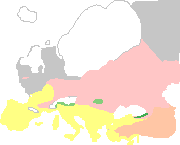 During the Lower Pleniglacial (around 65,000 years ago)
During the Lower Pleniglacial (around 65,000 years ago)
Interstadials. Sudden warm and moist phases occurred during the timespan of the last glacial phase, often taking the European climate from full-glacial (stadial) conditions to a climate about as warm as at present. Between 115,000 and 14,000 years ago, 24 of these warm events have so far been recognized from the Greenland ice core data (where they form part of a warm-cold pattern known as 'Dansgaard-Oeschger cycles'), although many lesser warming events also occurred (Dansgaard et al. 1993). From the speed of the climate changes recorded in the Greenland ice cap (Dansgaard et al. 1989), and by observation of the speed of change in sedimentation conditions on land, it is widely believed that the 'jump' in climate occurred over only a few decades. The interstadials lasted for varying spans of time, usually a few centuries to about 2,000 years (though the earliest ones, at Marine Isotope Stages 5a and 5c, lasted rather longer), before a rapid cooling returned conditions to their previous state. From ocean and ice-core evidence, it seems that most interstadials cooled by a series of decade-timescale steps, followed by one large terminal cooling event. The most recent 'interstadial', by the traditional European stratigraphy, is the late-glacial warm phase that ended in the Younger Dryas cold phase 11,000 14C y.a.
Interstadials show up in the north-west European record as brief influxes of temperate-climate invertebrates, often with intervals of peat deposition indicating a moist climate. At least the earlier interstadials in Scandinavea (before ice extent had built up fully to cover the region) had a birch (Betula) forest (van Andel & Tzedakis 1996). Forests or open woodlands of birch, pine and other conifers also recolonized the steppe and forest-steppe in northern Germany, the Netherlands and Britain (van Andel & Tzedakis 1996). Note that fossil bird faunas suggest that the interstadial tree cover was always rather open and that patches of steppe were never far away, except perhaps in unusually favoured sites (Tyrberg 1998). Many of the later interstadials, occurring as sudden warm phases against a background of drier and colder conditions in which local tree populations were not present, do not show this resurgence of woodland in northern Europe.
In southern Europe, trees may have started to expand out of their localised refugia during each interstadial, only to be decimated again when dry glacial conditions returned. For example, during each of the major interstadials, oaks (Quercus) underwent a temporary resurgence in Sicily (Rossignol-Strick & Planchais 1989). At least the early interstadials may have given a fairly widespread mixed forest cover across southern Europe, with mediterranean tree species present. However, in reality the tree cover may have been quite fragmented; the various bird faunas from southern Europe for the period between 110,000 and 14,000 years ago, no fauna has been found which suggests closed forest. Instead, there is a combination of bird species of open ground (e.g. steppe) with those which are more usually found in wooded environments (Tyrberg 1998). The later interstadials seem to have given rise to even more open tree cover across southern Spain, south and central Italy and Greece, (van Andel & Tzedakis 1996) with more pine and juniper in the relatively arid areas such as southern Italy and Greece.
T. Tyrburg (pers. commun. 1998) notes that some of the earlier interstadials during the last 110,000 years showed a very strong north-south climate gradient, with cold 'glacial-like' conditions persisting in Scandinavea correlating with 'interglacial-like' conditions in southern Europe: "This steeper gradient is true of both the early Würmian "megastadials" MIS 5a and 5c, perhaps in particular MIS 5a. It is indeed rather obvious when you compare conditions in e. g. France where vegetation and climate (and avifaunas!) seem to have been almost interglacial (see e. g. the Grande Pile profile where St Germain I and II were originally interpeted as full interglacials by Woillard) while in Scandinavia it was a great deal colder than at present with boreal taiga in southern Sweden, birch (Betula) forest in central Sweden and tundra in the north (in MIS 5a arctic desert might be a better description). An English-language citation for this is: Mangerud, Jan 1991: The last Interglacial/Glacial Cycle in Northern Europe. pp. 38-75 in: Shane, Linda C. K. & Cushing, Edward, J. (eds): Quaternary Landscapes. London, 229 pp. Mangerud´s comments on this matter are at p. 51. I would like to emphasize that MIS 5a and 5c were of quite a different order than "ordinary" interstadials both with respect to amplitude and length."
Stadials: brief intense cold phases
A number of sudden, intense cold and dry phases punctuate the climate history of Europe during the general period between about 110,000 and 11,000 14C y.a. against a background of relatively milder (though still generally colder and drier than present) conditions. The cold, arid phases show up in pollen records in both northern and southern Europe as sudden decreases in the percentage of tree pollen, and an influx of plants indicating cold, dry semi-desert or dry steppe conditions (e.g. in Spain; Burjachs & Julia 1994). Although the dating is in many cases somewhat uncertain, these cold, dry phases in Europe are generally thought to correspond to Heinrich events in the North Atlantic (cold phases of extensive ice rafting). Given the relatively detailed record of climate history from the North Atlantic and Greenland ice cores, the chronology of large Heinrich events given below (Table 1.) probably also applies to intense cold, dry phases on the European mainland, which is strongly affected by North Atlantic climate. Many other less intense brief cold phases also occurred in the North Atlantic, and these too might have affected European vegetation.
The H1 event and the H2 event might perhaps both represent the 'extreme' Last Glacial Maximum' conditions mapped below. If this is the case, slightly milder (though still more arid than present) conditions may have prevailed during some parts of this period. The Younger Dryas (11,000-10,000 14C y.a.) event also has the general features of a Heinrich Event and may be regarded as the most recent of these.
Table 1 Timing of major Heinrich events during the last 130,000 years (ages in calender years after Bond et al., 1997 for H0- H3; after Bond et al., 1993 for H4- H6). These cold, dry phases in the North Atlantic probably each affected the European mainland too.
YD or H0 12.2 ka (calendar age)
H1 16.8
H2 24.1
H3 30.1
H4 35.9
H5 50.0
H6 66.0
YD: Younger Dryas
H: Heinrich event
The following three time intervals are selected to illustrate the general range of variability in European climates and vegetation during the long 'middling' phase (Oxygen Istope Stage 3; 57,000-24,000 years ago). Stage 3 was characterised by an unstable climate that fluctuated greatly on timespans of a few thousand years. In the following example, the amount of data and the dating precision is probably sufficient to be able to realistically distinguish these three closely juxtaposed phases that correlate between different sites.
1) 43,000-41,000 y.a. (approx.), a brief interstadial event, about as warm as the present-day. This phase seems to have followed on suddenly from a previous phase somewhat drier and colder than present. Fossil beetle evidence found in eastern England by Coope suggests that in north-west Europe at least, this phase was comparable in warmth to the present-day (Huijzer & Isarin 1997). Conditions remained treeless, however, probably due to the lack of time for tree populations to return from more southerly refuges. The warmth ended suddenly, with a switch to extreme cold.
2) 41,000-39,000 y.a. (possibly corresponding in age to the Heinrich event H4?), a relatively cold phase (a Heinrich event) during the 'middling' period ago (Oxygen Isotope Stage 3).. Huijzer & Isarin (1997) have summarized the general climatic and ecological conditions for north-western and central Europe for this phase, based on a range of indicators including plant fossils, insect fossils, ancient dune features and permafrost features.
Huijzer & Isarin suggest that to the south of a large ice sheet (approximately following the southern limits of present-day Norway and Sweden), there would have been arid conditions with sparse vegetation cover, with aeolian sand sheets active, and some loess (windblown dust) deposition in areas where at least some vegetation was present. Mean annual temperature was similar to the high Arctic of the present-day; around -9 to -4 deg.C, and the mean temperature of the warmest month across north-west Europe was around 10-11 deg.C; equivalent to the tundra zones today. The coldest month would have varied from around -27 to -20 deg.C from north (Denmark) to south (northern France).
This interval, correlated with a Heinrich event or ice surge in the north Atlantic, was one of the intense cold and dry stages of the last 100,000 years in western Europe, though it is uncertain whether this cooling extended much outside of Europe (unlike the glacial maxima which seem to have been fairly global in their extreme conditions).
3) 39,000-36,000 y.a. (approx.), an example of a relatively mild phase during the 'middling' period between 57,000 & 24,000 years ago (Oxygen Isotope Stage 3). Milder conditions (though still much colder and drier than today) began around 39,000 or 38,000 years ago and lasted several thousand years.
A map (a version of which is currently in preparation for this page) is given by van Andel & Tzedakis (1996). A large ice mass existed over most of Fenno-Scandinavea. According to van Andel & Tzedakis (1996), forest extended across most of southern Europe, and steppe-tundra and open woodland predominated across northern Europe. This general vegetation distribution is representative of about half of the Stage 3 period overall (van Andel & Tzedakis 1996).
However, Tyrberg (1998) (and pers. comm. 1998) notes that none of the fossil bird faunas found in Europe between 100,000 and 11,000 14C ya contain predominantly forest-living taxa. This suggests that at no stage (including the early interstadials) was closed forest widespread in southern Europe or elsewhere in Europe. Bird species that prefer woodland or forest were usually present - except during the very coldest intervals - mixed in with species characteristic of more open vegetation, suggesting isolated clumps or pockets of woodland, not a continuous cover. At other times during Stage 3, temperatures were cooler and conditions drier than shown here. Sea level was about 70m below present level, but the extended coastlines are not shown here.
Europe during a relatively mild phase, 39,000-36,000 y.a.
Last Glacial Maximum/Full Glacial (22,000 14C years ago) to 14,000 14C years ago. The last late Glacial from 22,000 up until just before 13,000 14C years ago was very cold and dry throughout Europe. Large ice sheets were present over much of northern Europe, and ice caps covered the Alps and the Pyrennes. Forest and woodland were almost non-existent, except for isolated pockets of woody vegetation in and close to the mountain ranges of southern Europe. Instead, a sparse grassland or semi-desert covered most of southern Europe, whilst a mixture of the dry, open 'steppe tundra' and polar desert covered the parts of northern Europe not occupied by ice sheets. Ice-wedge features suggest that permafrost extended across most of Europe, down to about the latitude of central France. Drifting sand and wind erosion were common in north and central Europe, and desert animals such as Saiga antelope were present as far west as France.
Various geomorphological, zoological, botanical and isotopic temperature indicators suggest that all parts of Europe were much colder than today, with the greatest cooling being in winter (Frenzel et al. 1992). At about the latitude of south-central Germany and north-western Ukraine, Frenzel (1992a) presents maps suggesting August mean temperatures of about 10-11 deg. Celsius, comparable with much of the northern coast of Siberia at present. Winter (February) mean temperatures were at least as low as -19 Celsius in central Germany and -27 Celsius across most of the Ukraine, the latter being similar to much of northern and central Siberia at present. In southern Europe, across most of the Mediterranean zone, temperatures were perhaps 8-10 degrees lower than at present in both summer and winter (Frenzel 1992 a,b). It is interesting to note, however, that frost was not severe enough to wipe out relict populations of the endemic Mediterranean date palm, Phoenix theophrasti, from the warmest parts of Crete and the SE Aegean (Rackham, in press)
Lake level evidence from southern Europe (Harrison et al. 1996) gives the paradoxical picture of moister-than-present or only slightly drier conditions during the LGM and late glacial; the wider evidence (e.g. palaeobotanical evidence, slope wash sediments) shows that in fact the 'ecological' aridity (experienced by plants) was actually much more severe than today. This contradiction within the evidence may relate to the patterns of rainfall; for example very few sudden storms, concentrated in winter when the plants were not growing (Prentice et al. 1992), or (very speculatively) the drought-effects of lower CO2 on vegetation despite high overall rainfall. Lake levels suggest that in fact the most arid phase of all was reached around 15,000 14C y.a, shortly before the intial interglacial warming occurred.
As mentioned above, the ice cap and north Atlantic sediment chronology suggests that in fact the maximum cold and aridity of this general period is a composite picture of two large cooling phases or Heinrich events (around 21,000 and 17,000-15,000 'real' years ago). These may have been separated by a somewhat milder period, lasting several thousand years, which shows up in southern European pollen records as a 'blip' of pine (Pinus) pollen.
The data sources for this area are summarized in more detail in the QEN review.
Europe under full glacial conditions - 22,000 - 14,00014C ya
 Europe under full glacial conditions
Europe under full glacial conditions
A large ice sheet (white) covers Scandinavea, and most of northern and central Europe is covered by steppe-tundra vegetation (reddish colour), a sparse vegetation existing under dry, cold climates (erratum; northern France should be coloured as steppe-tundra, not steppe). In southern Europe, slightly warmer conditions give a dry, almost semi-desert steppe (yellow). The few surviving areas of rather open wooded cover are shown in green.
13,000 14C years ago. A rapid warming and moistening of climate all across Europe occurred shortly before this time, with insect communities in NW Europe suggesting conditions as warm or warmer than the present-day for about the first 500 14C years (Atkinson et al. 1987).
Across most of Europe there was a change in herbaceous communities away from dry and cold-climate steppe-tundra and towards steppe, with a slower response in terms of wooded cover. However, open woodland consisting of birch and various boreal conifers seems to have appeared across much of European Russia very quickly following the warming event (Velichko 1993), although western Europe and Iberia remained largely open steppe for several hundred 14C years afterward. North-western Europe remained lacking in trees, with open tundra and some dwarf shrubs (juniper, dwarf willows) present during the 13,000- 12,000 14C y.a. interval (Anderson 1997).
Europe soon after the onset of interglacial conditions - 13,000 14C ya
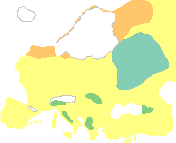 Europe following the initial interglacial warming
Europe following the initial interglacial warming
The suddenness of this warming event left ecosystems out of equilibrium. Trees had not yet had time to spread back over Europe, and a steppe cover (yellow) predominated. The ice sheets (white) in the north began to melt back, but their size meant that this took thousands of years even in the warmer climate. Some open woodland cover (green) appeared in western Russia quite rapidly - within a few hundred years - after the initial warming events, and woodland cover (green) began increasing in the mountainous areas of southern Europe where trees had survived the glaciation.
12,000-11,000 14C years ago. Pollen cores from across Europe show that following the initial amelioration of climate that had occurred at 13,000 14C y.a., open wooded vegetation had returned to much of Europe by around 12,000 14C y.a. (Velichko 1995, Huntley 1988, Huntley & Birks 1988, Turner & Hannon 1988). However, north-western Europe remained essentially treeless throughout the 12,000-11,000 14C y.a. interval, with only a very patchy open covering by birch (Betula) towards the end of this interval. Even the dwarf shrubs that had been present initially at 12,000 14C y.a. declined during the brief 'Older Dryas' cooling phase (about 12,000-11,800 14C y.a.) (Anderson 1997), with a resurgence of tundra vegetation due to the cooler conditions. Even after the Older Dryas ended, conditions did not fully return to the warmth of the 12,000-11,000 14C y.a. interval, though park-tundra with birch woodlands predominated in north-western Europe (Anderson 1997).
During the 12,000-11,000 14C y.a. interval, the steppe vegetation of the Mediterranean areas began to be replaced by woodlands, with relatively 'boreal' species such as birch (Betula) and willow (Salix) prevailing in southern France and the Pyrennes (Guiot & Pons 1986). Typical 'mediterranean' tree species such as evergreen oaks and pistacio do not seem to have been common in the Mediterranean region during these early stages. Dense forest was already present in some areas. For example, in the west Pyrennes piedmont, pine and beech forest was already in place by 12,000-11,500 y.a. (Jalut et al. 1988). Rackham (in press) suggests that evergreen oak (Quercus rotundifolia) savanna vegetation, with Artemisia and Chenopodiaceae, began to appear about this time in the Sierra Nevada of southern Spain, and that it remained in place until about 9,500 14C y.a. when it was eventually replaced by closed oak forest. At sites in Greece, deciduous oaks and pines were present, but they remained a minor component in a dry Artemisia-rich steppe (Rossignol-Strick 1995).
Europe before the Younger Dryas - 12,000 - 11,00014C ya
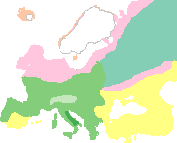 Europe shortly before the Younger Dryas
Europe shortly before the Younger Dryas
Continued warm conditions - though with some cooling - allowed open woodland cover (green) to spread back over much of southern, central and eastern Europe. Coniferous woodland predominated in eastern Europe (blue-green). Some closed forest vegetation formed in central Italy. In the north-west of Europe, tree cover (mainly birch and pine e.g. Hoek 1997) remained relatively sparse, and steppe-forest (pink) predominated. In parts of southern Europe, steppe vegetation (yellow) remained predominant.
Younger Dryas cold interval (approx 10,800-10,000 14C y.a.). This cold and dry period saw the temporary disappearence of the woodland cover that had previously extended over much of Europe (both north and south), and its replacement by dry steppe and steppe-tundra (Velichko 1993, Jalut 1992, Laval et al. 1991, Starkel 1991).
However, conditions might not have been so severe across north-western Europe, during the Younger Dryas period, with forest-steppe (a mixture of patches of trees and grassland) being widespread. For example, Sjoerd Bohncke and Wim Hoek (pers. comm. January 1998) disagree with the web page map reconstruction that is shown below.
They feel that there is not sufficient evidence to invoke"a steppe tundra as far west as northern Germany the Netherlands and Denmark. Even northern Poland shows only a minor increase in the Chenopods and Artemisia during the Younger Dryas. Most of Poland and Germany were a forest tundra, intermingled with some steppe elements. The northern-most region of Poland and Germany, close to the Scandinavian ice sheet was a shrub tundra. Teresa Madeyska (1995) has produced paleo vegetation maps for Poland during the Vistulian (=Weichselian) Lateglacial. The NASP group with John Lowe have produced several publications on the topic and a special issue of Quaternary Science Review (Vol.12,1993) contains several contributions of members of this NASP working group. We feel that Steppe Tundra (on the web page map) reflects a vegetation type indicating conditions that are much too dry. The Younger Dryas in the Netherlands, especially the first half, is dominated by wet conditions (see contribution Bohncke in QSR 1993, 12, 707-717). Only during the latter part dry conditions prevailed, eolian activity increased and some steppe elements appear in the pollen record. Velichko for the European part of Russia is a good reference. Journal of Quat. Science 1994, vol 9. and Quaternary International 1995, vol 28 and QSR 1993, vol 12. Teresa Madeyska,1995 Przeglad Geologiczny vol 43-7.". In his 1997 paleogeographic atlas of the Netherlands (Hoek W. 1997. Atlas of Paleogeography of Lateglacial Vegetation. Netherlands Geographical Studies 231. Utrecht), Hoek does however describe relatively dry conditions in both the early and late parts of the Younger Dryas, favouring open herbaceous vegetation on a range of soil types. Trees such as pine (Pinus) did remain present to some extent, though they were less common than before. As far as the western fringe of Europe is concerned, it seems that conditions through most of the Younger Dryas were drier than present but nowhere near as dry as the Last Glacial Maximum.
It may be the time for some re-drawing of my preliminary vegetation map of the Younger Dryas to show much more forest-steppe, even during the most severe phases of the Younger Dryas period.
Evidence from North Atlantic sediment cores and also from loess stratigraphy in China (Zhou et al. 1996) suggests that the Younger Dryas had a relatively mild period in its midst, separating two longer cold phases. Anderson (1997) suggests this may have occurred in Scotland.The mild period presumably would have extended across Europe too, though there does not seem to be any explicit evidence or discussion of this so far.
The sheer speed with which the Scottish Icecap returned during the Younger Dryas may also be evidence of moist conditions during at least the first part of the period (Tyrberg pers. comm.). Note that the map I show here should include a slight ice advance at the southern edge of the Scandinavean ice sheet associated with the Younger Dryas.
During parts of the Younger Dryas, summer temperatures in Scotland were about 9 deg.C lower than at present, with lesser changes of 4-5 deg.C in July temperatures in NW Germany and Scandinavea, where a large ice mass remained (Anderson 1997). After an initial stage of coldest temperatures there may have been a slight amelioration before the sudden ending of the Younger Dryas about 10,000 14C y.a.
Aridity during the Younger Dryas may have been much more severe in south-eastern Europe. In her review of pollen and isotopic data from the eastern Mediterranean region and Near East, Rossignol-Strick (1995) suggests that in many areas of Greece and across Turkey, the Younger Dryas period was even more arid than the most extreme part of the last glacial. She notes that 'desert' plants of the Chenopodiaceae were relatively more abundant than the 'semi-desert' Artemisia, and suggests that this indicates an annual precipitation of less than 150mm across much of lowland Greece (e.g. Lake Xenas, 500m, in South-central Greece, and Tenaghi Philippon in northern Greece, 50m), north-west Syria (e.g. Orontas Valley) Turkey (e.g. Lake Van, in eastern Anatolia), and the western Zagros mountains of Iran (Zeribar). Rossignol-Strick also notes that temperatures were markedly lower, with species characteristic of the very continental Asian semi-deserts occurring in lowland northern Greece. At the Greek sites, pine (Pinus) seems to have been present in relatively minor quantities, and pollen of temperate deciduous trees remains present (at very low abundance) during the Younger Dryas. Northern Israel (e.g. Lake Hule, in the upper Jordan Valley) was perhaps less arid than other parts of the region, and seems to have had a vegetation cover which included a large component of grasses, and some arboreal pollen as well as Artemisia and chenopods (Rossignol-Strick 1995). Perhaps the vegetation there would have been more like a dry steppe, with some savanna.
The sudden ending of the Younger Dryas around 10,000 14C years ago - which seems to have been mainly completed over about 75 years according to the latest interpretation of a detailed Greenland ice core - marks the beginning of the Holocene interglacial. However, the ice core evidence also suggests that mean temperatures around the North Atlantic region remained slightly lower than present, for about 1000 calendar years after the initial 75-year spurt of warming had been completed. They then warmed to give peak Holocene warm conditions.
Europe during the Younger Dryas - 10,800-10,000 14C ya
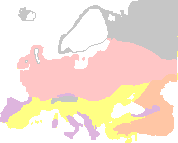 Europe during the Younger Dryas
Europe during the Younger Dryas
9,000-8,000 14C years ago. Forest had by now returned to most of Europe following the end of the cold Younger Dryas at 10,000 y.a.. The transition to peak Holocene levels of tree cover in the eastern Mediterranean seems to have taken about 1000 14C years following the end of the Younger Dryas (Rossignol-Strick 1995). Even at 9,000 y.a., however, in many parts of Europe the forest cover was still rather more open than at present with more herbaceous glades (Starkel 1991, Huntley 1993, Roberts & Wright 1993, Peterson 1993). By 8,000 y.a. the forest had become closed, but with conifers more abundant than at present in eastern Europe. See also QEN review for 8,000 y.a.
Rackham (in press) reviews the pollen evidence for the mediterranean 'wildwood' at about 9,000 14C y.a., from sites across southern Europe. He notes that almost everywhere, 'northern' deciduous species (e.g. hornbeam - Carpinus, deciduous oaks) were either dominant or abundant in what is presently evergreen oak woodland, pine woodland or scrub. About 9,500-8,000 14C y.a., closed oak forest consisting of both deciduous and evergreen oaks prevailed in the Sierra Nevada of southern Spain (Rackham, in press, Huntley & Birks 1983). Deciduous oaks, and to some extent evergreen oak and pine, formed a savanna vegetation in many parts of Greece (e.g. near the pollen sites at Lake Xynias, Lake Kopais, and Navarino). Only southern Crete seems to have had a 'real' mediterranean vegetation, with abundant steppe, savanna and oak maquis, and some garrigue-type vegetation. Even here, northern trees were present.Rossignol-Strick (1995) reviews the evidence for various sites in the eastern Mediterrean (Greece, Israel, NW Syria) and the Near East (Zagros mountains), and suggests that following a transion period of gradual tree recolonization and/or climate change between 10,000 and 9,000 14C y.a., the most heavily wooded conditions of the Holocene occurred between 9,000 and 6,000 14C y.a., with abundant pistacio Pistacia in open pistacio and almond (Amygdalus) woodlands or steppe in drier places such as the Zagros mountains (e.g. Zeribar), and in closed deciduous oak, hazel, hornbeam (with a minor pistacio and steppe element) forest in moister regions such as Greece. Northern Israel seems to have had open woodlands, rich in pistacio.
Changes were beginning to occur by the end of this time slice. In Greece and Cyprus, the plant fossil record suggests that the 'typical' mediterranean vegetation of evergreen trees and shrubs expanded mainly from 8,000 14C y.a. onwards (O. Rackham, in press). Up until then, deciduous forest trees had been dominant or abundant in most areas.
In agreement with the vegetation evidence, lake level evidence for the 9,000-8,000 14C y.a. time slice suggests that slightly wetter-than-present conditions predominated across most of central and southern Europe, and along parts of the western edge of Europe (Harrison et al. 1996). The lake level evidence also suggests that moisture conditions were similar to today (though possibly slightly drier) in southern England, southern Scandinavea and the eastern Baltic. Although early Holocene climates may have been slightly moister in southern Europe, it is thought that most of the 'aridization' of vegetation that has taken place since is due to human intervention in cutting and burning forests - resulting in thinner, droughty soils and sparser more drought susceptible vegetation - rather than a real effect of climate (Rackham, in press).
Europe during the early Holocene - 9,000 - 8,000 14C ya
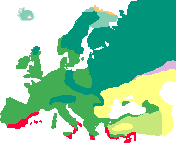 Europe during the early Holocene
Europe during the early Holocene
7,000-5,000 14C y.a. Warmer-than-present climates allowed forest to spread further north. There are various sources of evidence for warmer summer and winter temperatures across northern Europe during the mid-Holocene (e.g. Vork & Thomsen 1996); these include pollen evidence of plants extending further north, and aquatic and terrestrial invertebrates. The diverse data have been been summarized into climate map reconstructions, indicating about a 1 deg.C warming in mean July temperature at 50 degrees North, a 2 degrees warming above 60 degrees North, and 3-4 degree warming above about 65 degrees North (Klimanov et al. 1992). A winter warming of about 2 degrees is suggested for most of north-west Europe (Klimanov & Velichko 1992). The available indicators do not all agree on the same time slices or intervals for maximum warming, but in general it seems that the period between 7,000 and 4,000 14C years ago includes the warmest part of the Holocene in most areas.
Lake level evidence (Harrison et al. 1996) suggests that the mid-Holocene climate may have been somewhat moister than present across the northern Mediterranean region, but slightly drier in northern Europe.
A severe cold and dry event, lasting perhaps a couple of centuries, shows up in the Greenland ice cores around 7,500 14C y.a. (8,200 cal. y.a.) and has been correlated with cold and aridity (but with moister conditions in NW Europe; see below) in many parts of the world (Alley et al. 1997). The temperature lowering in the north Atlantic seems to have been about half-way as severe as that associated with the Younger Dryas. It is possible that this cooling event would have extended across Europe, and a rapid cooling (and onset of wetter peat-forming conditions) has indeed been noted by Anderson (1996) for NW Scotland at about 7,400 14C y.a.
At about 6,000 14C y.a. (7,500 cal. y.a.), rising Mediterranean sea waters broke through the Bosphorous. In perhaps less than a year, the Black Sea became brackish and rose several hundred feet, inundating former shores and river valleys deep into the interior. The waters would have encroached on the land at a rate of about 1 km a day. More than 60,000 square miles of land were soon submerged, a 30 percent expansion in the Black Sea's size, which essentially gave the body of water its modern configuration. An international team of geologists and oceanographers (led by W. Ryan & W. Pittman of Lamont-Doherty) has reconstructed the history of this catastrophic flood from data gathered by a Russian research ship in 1993. Seismic soundings and sediment cores revealed traces of the sea's former shorelines, showing an abrupt 500-foot rise in water levels. Radiocarbon dating of the transition from fresh-water to marine organisms in the cores put the time of the event at about 6,000 14C y.a.
During the 7,000-5,000 14C y.a. time interval, agriculture spread to most parts of Europe. By around 7,000 14C y.a., occasional burning of the forests by humans may have caused an increase in the fire-resistant cork oak (Quercus suber) in the Sierra Nevada of southern Spain (Rackham, in press). Cereal and olive pollen also begin to appear soon afterwards, suggesting sporadic cultivation.
By about 5,000 14C y.a., spreading peat growth was beginning to affect the forest areas of NW Britain, perhaps due to ongoing leaching of soil nurients, with occasional forest clearance for agriculture accelerating soil leaching and allowing the beginning of peat buildup.
In most parts of Europe, however, agriculture was probably still not significant as a modifier of landscape at any stage during this time interval (except on a very local scale), even though agriculturalists were present at low densities through most of Europe by 5,000 14C y.a. The main areas of extensive forest clearance by 5,000 y.a. were, (rather paradoxically) towards the opposite extremes of Europe, geographically and climatically. Crete and localised areas of Greece were showing significant forest clearance and erosion, and quite extensive areas of the English chalklands were already cleared of forest with abundant agriculture. At about 5,000 14C y.a., there is a rapid and fairly simultaneous decline in elm (Ulmus) throughout Europe. At first, this was taken to suggest widespread cutting of elm trees and branches by cattle herders living within the forests, but it is now thought to be due to elm disease, possibly (though more controversially) due to weakening of the trees by a sudden climate deterioration. The subject is discussed by B. Huntley in this review article
Europe under mid-Holocene conditions - since 7,000-5,000 14C ya
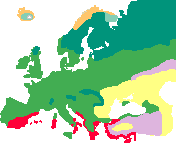 Europe during the Mid Holocene
Europe during the Mid Holocene
By about 4,000 14C y.a., agriculture exerted significant effects on the landscape in most parts of Europe, although before about 3,000 14C y.a. large areas of forest in central and northern Europe were probably still untouched by farming.
Anderson (1996) suggests a rapid cooling and moistening of climate around 4,000 14C y.a. in NW Scotland, which may relate to a cooling and drying of climate at around this time in other areas, across northern Africa and southern Asia.A widespread cool and wet phase seems to have affected north-west and central Europe, with increase in bog growth and lowering of altitudinal tree limits, around 2,600 14C y.a. (also 2,600 'real' y.a.). The diverse evidence for this event is summarized by van Geel et al. (1996).
Another very brief cold phase is recorded from about 1,400 y.a., (about 536 A.D.) lasting two to three years. This shows up strongly in tree growth rings from western Europe (Baillie 1994), and coincides with records from the Greenland ice cores, the Mediterranean, China, and the south-western USA showing either fairly direct evidence of cold growing seasons, or famines. The most likely cause is a volcanic dust layer, which shows up in the ice core records (Baillie 1994).
 Europe around 4,500 14C y.a., just before main deforestation/agriculture phase
Europe around 4,500 14C y.a., just before main deforestation/agriculture phase
large climate changes in Europe/Near East during the last 15,000 calendar years (note that these dates are in 'real' years not radiocarbon years).
14,500 y.a. - rapid warming and moistening of climates. Rapid deglaciation begins.
13,500 y.a. - climates about as warm and moist as today's
13,000 y.a. 'Older Dryas' cold phase (lasting about 200 years) before a partial return to warmer conditions.
12,800 y.a. (+/- 200 years)- rapid stepwise onset of the intensely cold Younger Dryas. Much drier than present over much of Europe and the Middle East, though wetter-than-present conditions at first prevailed in NW Europe.
11,500 y.a. (+/- 200 years) - Younger Dryas ends suddenly over a few decades, back to relative warmth and moist climates (Holocene, or Isotope Stage 1).
11,500 - 10,500 y.a. - climates possibly still slightly cooler than present-day.
9,000 y.a. - 8,200 y.a. - climates warmer and often moister than today's
about 8,200 y.a. - sudden cool phase lasting about 200 years, about half-way as severe as the Younger Dryas. Wetter-than-present conditions in NW Europe, but drier than present in eastern Turkey.
8,000-4,500 y.a. - climates generally slightly warmer and moister than today's.
(but; at 5,900 y.a. - a possible sudden and short-lived cold phase corresponding to the 'elm decline').
Since about 4,500 y.a. - climates fairly similar to the present
2,600 y.a. - relatively wet/cold event (of unknown duration) in many areas
(but; 1,400 y.a. {536-538 A.D.} wet cold event of reduced tree growth and famine across western Europe and possibly elsewhere).
(Followed by 'Little Ice Age' about 700-200 ya)
See also QEN review for 5,000 y.a.